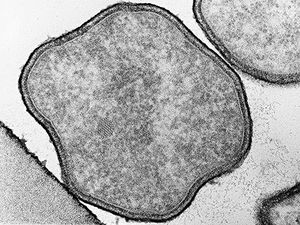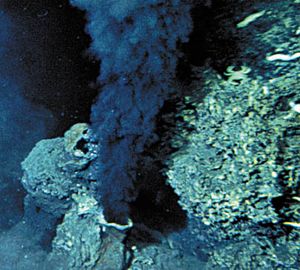Pyrolobus fumarii: Difference between revisions
No edit summary |
No edit summary |
||
| Line 29: | Line 29: | ||
==Metabolism== | ==Metabolism== | ||
''Pyrolobus fumarii'' is a facultatively aerobic obligate chemolithoautotroph. Moreover, ''P. fumarii'' is hydrogen – dependent gaining energy by H2 oxidation at a very low oxygen concentration and uses CO2¬ as the single carbon source. | |||
There are three different metabolic types observed on electron acceptor dependence: | |||
# Nitrate Ammonification | |||
** Nitrate is used as a terminal acceptor during strict anaerobic conditions wherein NO<sub>3</sub><sup>-</sup> and H<sub>2</sub> are present. | |||
<CENTER>4H<sub>2</sub> + H<sup>+</sup> + NO<sub>3</sub><sup>-</sup> --> NH<sub>4</sub> + OH<sup>-</sup> + 2H<sub>2</sub>O</CENTER> | |||
In the process, ammonia is formed during NO3- reduction. | |||
==Ecology== | ==Ecology== | ||
''Pyrolobus fumarii'' is an extreme hyperthermophile isolated in the wall of a black smoker, or a deep-sea hydrothermal vent formed by sulfur-bearing minerals from beneath the Earth's crust, located in the Mid-Atlantic Ridge. It thrives at temperature of superheated water with optimal temperature at 106ºC and will not grow below 90ºC. Its optimum pH is 5.5 and grew between 4.0 – 6.5 while salt concentration is between 1%-4% with 1.7% as its optimum. | |||
[[Image:Hydrothermal vent.jpg|thumb|Caption text]] | |||
==References== | ==References== | ||
Revision as of 23:38, 15 April 2008
Pyrolobus fumarii
Classification
Higher order taxa:
Archaea; Crenarchaeota; Thermoprotei; Desulfurococcales; Pyrodictiaceae
Species:
Pyrolobus fumarii (Synonyms: Pyrolobus Blochl et al. 1999)
Description and Significance
Pyrolobus fumarii are made up of cells that are regulary to irregulary lobed cocci. Chemolithoautotrophic growth by anaerobic and microaerophilic H2 oxidation with NO3-, S2O32-, and O2 as electron accepters. By doing so well at temperatures of 95ºC to 113ºC, our knowledge about the upper limits of life is expanded.
Genome Structure
DNA Base composition Determined by a direct analysis of its mononucleosides and melting point analysis,Pyrolobus fumarii has a cytosine-guanine composition of 52.9mol% and 53.4mol% respectively. (Blöchl et al. 1997)
DNA-DNA homology The closest relatives of Pyrolobus fumarii are members of Pyrodictium based off 16S rRNA partial sequencing. There is insignificant DNA homology between Pyrolobus fumarii, Pyrodictium occultum, and Pyrodictium abyssi as shown in a DNA/DNA hybridization. (Blöchl et al. 1997)
Cell Structure
Pyrolobus fumarii are cells are regularly to irregularly lobe-shaped cocci (0.7-2.5 microm in diameter) arranged singly and
Metabolism
Pyrolobus fumarii is a facultatively aerobic obligate chemolithoautotroph. Moreover, P. fumarii is hydrogen – dependent gaining energy by H2 oxidation at a very low oxygen concentration and uses CO2¬ as the single carbon source.
There are three different metabolic types observed on electron acceptor dependence:
- Nitrate Ammonification
- Nitrate is used as a terminal acceptor during strict anaerobic conditions wherein NO3- and H2 are present.
In the process, ammonia is formed during NO3- reduction.
Ecology
Pyrolobus fumarii is an extreme hyperthermophile isolated in the wall of a black smoker, or a deep-sea hydrothermal vent formed by sulfur-bearing minerals from beneath the Earth's crust, located in the Mid-Atlantic Ridge. It thrives at temperature of superheated water with optimal temperature at 106ºC and will not grow below 90ºC. Its optimum pH is 5.5 and grew between 4.0 – 6.5 while salt concentration is between 1%-4% with 1.7% as its optimum.


